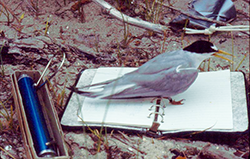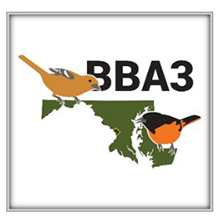A Brief History of the MD/DC Breeding Bird Atlas
 The first Atlas of the Breeding Birds of Maryland and the District of Columbia began in 1983 and ran through 1987. The goal was to establish a baseline data set for future studies. Under the supervision of Project Coordinator Eirik A.T. Blom, over 800 volunteer field observers collected nearly 92,000 distinct records, achieving 99% coverage of the study area. This dataset augmented historical distribution data collected since the mid-1800s, nest records dating back 100 years, Breeding Bird Censuses since 1948, and Breeding Bird Survey records beginning in 1966. Primary funding was provided by the Maryland Ornithological Society, the Maryland Department of Natural Resources, and supported by generous donations from countless individuals and private and public organizations. The final document, a 500-page book of illustrated species descriptions and distribution maps, was published in 1996, guided by Senior Editor, Chandler S. Robbins.
The first Atlas of the Breeding Birds of Maryland and the District of Columbia began in 1983 and ran through 1987. The goal was to establish a baseline data set for future studies. Under the supervision of Project Coordinator Eirik A.T. Blom, over 800 volunteer field observers collected nearly 92,000 distinct records, achieving 99% coverage of the study area. This dataset augmented historical distribution data collected since the mid-1800s, nest records dating back 100 years, Breeding Bird Censuses since 1948, and Breeding Bird Survey records beginning in 1966. Primary funding was provided by the Maryland Ornithological Society, the Maryland Department of Natural Resources, and supported by generous donations from countless individuals and private and public organizations. The final document, a 500-page book of illustrated species descriptions and distribution maps, was published in 1996, guided by Senior Editor, Chandler S. Robbins.
The 2nd Atlas of the Breeding Birds of Maryland and the District of Columbia began in response to concerns by birding enthusiasts that certain species of birds no longer nested in parts of the State identified in the first Atlas. In the early 2000s, Atlas Committees from Maryland and the District of Columbia, surrounding states, and Canadian provinces decided that it was time to conduct a second atlas to document species changes over a larger geographical area. Once again, volunteer field observers stepped up. Under the leadership of dedicated county coordinators and the guidance of Project Coordinator Walter G. Ellison, over 1000 volunteers compiled over 190,000 records of 206 bird species across the state. Roadside surveys were repeated from the first atlas to provide information on relative abundance. The Maryland Ornithological Society and the Maryland Department of Natural Resources were the primary financial sponsors. This atlas also benefitted from the data collection, analysis, management, and presentation expertise of the US Geological Survey’s Biological Resource Division. Walter Ellison edited the final document, a 502-page book showcasing species accounts with full color photos, maps highlighting distribution changes, and species conservation efforts.
